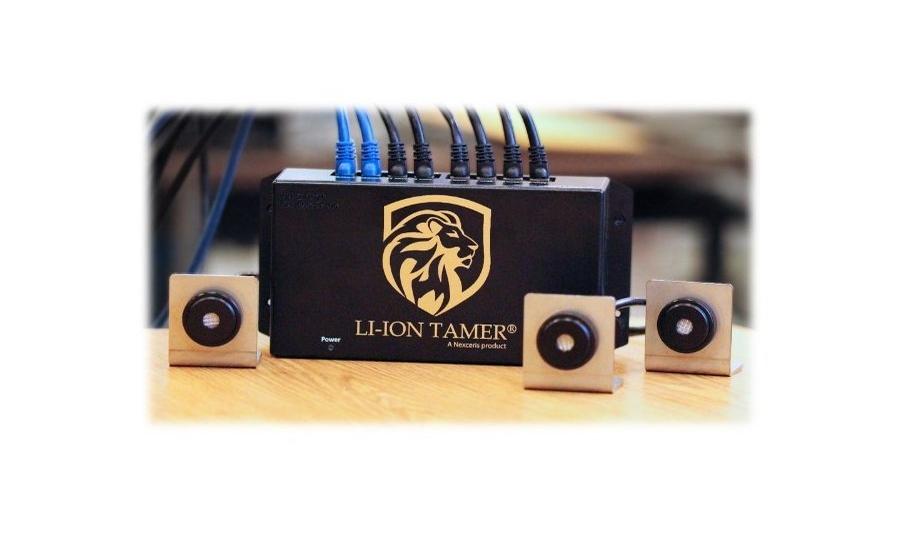For backup power systems, a de facto industry standard is increasingly being installed in Battery Energy Storage Systems to help tame the dangers of thermal runaway.
At data centers across the United States, demand for Battery Energy Storage Systems (BESS) is rapidly increasing. Comprised of an interconnected series of batteries, BESS are self-contained, rechargeable battery units that store energy, which they can then disperse in case of power loss. This makes BESS battery back-up systems an ideal backup power source for data centers.
Despite the significant benefits, BESS are subject to thermal runaway conditions because, at their core, they utilize rechargeable batteries. However, the risks associated with the use of BESS can be exacerbated with the implementation of lithium-ion (Li-ion) batteries. In Li-ion BESS scenarios, thermal runaway can occur due to thermal abuse or overcharging, which can cause excess heat to create a reaction that increases the internal temperature of the battery. The increase in heat can cause the electrolyte solution inside of a Li-ion battery to begin to turn into a vapor.
If left unchecked by built-in system protections or the Battery Management System, this process can continue to increase temperatures and pressure inside of the hermetically sealed battery cell, eventually causing the battery cell separator to melt down and degrade.
This stage of Li-ion battery failure is referred to as “off-gassing” or “initial cell venting.” Failure to address the continued increase in heat at this stage will result in the internal temperature of the battery continuing to rise until a point of thermal runaway, which can propagate into fires in adjacent cells and other combustibles in the area.
Although smoke and gas detectors are required by code in BESS, smoke detectors are searching for particles of combustion, which are not present until thermal runaway occurs. Most gas detectors are designed to manage threats in lead-acid battery BESS and so detect either a generic hydrocarbon gas or quantity of gas at one physical location.
Due to these factors, traditional smoke and gas detectors used in a Li-ion BESS may only indicate a thermal runaway event once it is already occurring inside the container, rather than providing sufficient warning to prevent a fire.
Now, a growing number of fire authorities and life safety system experts are addressing this issue by recommending detection technology that provides a warning far earlier than traditional monitoring and detection methods. This helps to stop thermal runaway before it begins, increasing data center safety and reliability.
The approach is not only being adopted throughout the country but also is increasingly being adopted by fire authorities as a de facto standard for Li-ion BESS applications.
“Today, the new technology for preventing thermal runaway is ahead of the [NFPA] code and most Authorities Having Jurisdiction (AHJs) are open to technology that satisfies the code’s intent. So, the consensus is moving toward installing Li-ion-specific early warning detection systems over more generalized gas detection technologies,” says Kenneth Pope, President and Owner of Pope Technologies LLC, a fire alarm and smoke control life safety systems designer and installer. The company has offices in Arizona, Nevada, Texas, and Utah, and Pope has worked in the industry for more than 25 years.
Seeking Earlier Li-ion Detection, Greater Safety
With Li-ion BESS applications expanding around the globe, the need for better protection from thermal runaway is increasing and becoming a crucial topic among fire departments and other AHJs. The danger is emphasized by incidents such as a runaway Li-ion battery explosion that injured nine first responders at the McMicken Energy Storage facility in Surprise, Arizona in April 2019.
So, when an area data center decided to install a large quantity of Li-ion BESS, the local AHJ required that gas detection solutions be retrofitted into the eight existing BESS containers as well as additional BESS containers planned for the site.
To satisfy the requirements for the project, the AHJ contacted Randy Snow, Managing Principal at Progressive Edge Technologies, a Phoenix, Arizona-based fire and life safety system consulting firm. Snow considered code-approved gas detection systems used in BESS, but wishing to provide a more robust solution, he began searching for alternatives. He consulted with Kenneth Pope at Pope Technologies, who recommended Li-ion Tamer, a detector that specifically targets the off-gas electrolyte vapor that is characteristic of a Li-ion battery cell vent release.
Li-ion Tamer by Honeywell consists of two primary components: a controller and a network of off-gas sensors installed above the battery racks. The sensors utilize sophisticated detection algorithms to monitor Li-ion BESS and provide an alert to the initial venting of electrolyte solvent vapors. This early warning helps prevent fires by allowing increased time to shut down the charge to the affected rack(s) in the estimated 8-15 minutes between off-gassing of the electrolyte vapors and the beginning of thermal runaway.
The Li-ion Tamer controller is designed to diagnose when and where the off-gassing of electrolyte vapors is occurring, with an electrolyte solvent release of just a single battery cell. This enables quick alarm initiation and immediate mitigation measures such as opening louvres, engaging exhaust fans, and alerting occupants and first responders of the off-gassing event via the NOTIFIER Fire Alarm Control Panel.
“The AHJ liked the idea of providing an early warning detection system along with a means of suppression before thermal runaway,” says Snow.
Still, the AHJ had to approve safety measures involving a gas detection requirement. “We had a fire protection engineer review our documents and confirm that our use of Li-ion Tamer would satisfy the AHJ’s gas detection requirement for their jurisdiction. We got their blessing and approval,” says Snow.
Snow states they now utilize Li-ion Tamer in the data center BESS, along with other fire detection and suppression technologies. This includes a VESDA aspirating smoke detector for early warning smoke detection because the heat from a combustion fire in the BESS can trigger a Li-ion thermal runaway event as well.
The VESDA VLF aspirating smoke detection system was chosen for this task. The VESDA system continuously draws in small samples of air through holes in piping or tubing and evaluates it for smoke particles at a central location. This provides very early smoke detection capability, even before smoke becomes visible. The system provides several programmable alarm thresholds that help enable a swift escalating response, which can help to stop a fire and minimize potential damage before fire suppression release.
“When combined with VESDA and fire suppression system elements, Li-ion Tamer provides the tools and the interface we need to protect BESS essentially anywhere they are installed. Li-ion Tamer is a flexible, effective option that can take the place of traditional gas detection,” says Snow, adding that many BESS units will be retrofitted with this technology over the course of the next year for data centers in Virginia, Florida, Texas, and Oregon.
According to Pope, the importance of Li-ion-specific early warning detection systems will only increase, given the rapid growth of Li-ion BESS beyond data centers. Today, BESS systems are being installed by utilities, renewable energy producers, and those in the industrial, retail, defense, healthcare, and transportation sectors.
“We expect thousands of these pods to be manufactured in the next couple of years,” says Pope. “It is all about effectively increasing the level of protection and decreasing the level of risk. It just makes sense for end users to protect their BESS investment.”
For more information, contact Dawn Wotapka, Director of External Communications at Honeywell, 715 Peachtree Street, N.E., Atlanta, GA 30308; email: dawn.wotapka@honeywell.com.



